TYPICAL AUTOMATED ASSEMBLY PROCESS
Outline:
Overview of Electronic Assembly
Introducing Boards Into the Line
SMT Solder Paste Application
Parts Placement
Soldering Machine
Accumulation
Double Sided Board
Double Sided Alternate Approach
Cleaning & Testing
Automated In-line Inspection
Interconnect Conveyors
Thru Line Walkway
Manual Assembly
Overview of Electronic Assembly
There are many variables that can change the type of equipment to be used depending on the specific steps required in the product assembly process. A few of these may include whether you are using Surface Mount Technology (SMT) or Through Hole; is there any hand assembly required; are there any components that must be soldered at a different point in the assembly process than the majority of the components? These are just a few issues that could change the steps and layout of a production line. We at Dynapace have over 25 years experience in the field of PCB handling and assembly and would be happy to review your situation and discuss the options available to you as you plan your production line.
The typical flow of boards in a PCB assembly line is from left to right and the standard line height is 37 +/- 1 inches above the floor.
Back to the Top
Introducing Boards Into the Line 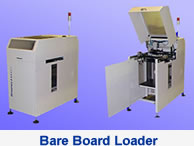
In almost all situations a bare board loader, which may also be called a destacker or line loader, is used to feed unpopulated printed circuit boards into the line at the beginning of the production line. Dynapace offers 2 units one that will hold an 18-inch stack and the other a 6-inch stack of up to 18 x 18 inch boards. We also offer a heavy duty unit that can handle boards up to 44" by 24". In any practical production line a Bare Board Loader is a must otherwise manual PCB loading by an operator is required.
Back to the Top
SMT Solder Paste Application
If Surface Mount Technology (SMT) is being used in the assembly process the next item usually found in the typical production line is the Screen Printer. This unit applies a film of solder paste to the boards at the points where components are going to be soldered to the board. This works something like silkscreen printing on a T-shirt. A mask is made that only allows the paste to be "printed" only in the desired areas.
Back to the Top
Parts Placement
Following the Screen Printer sometimes an automated optical inspection unit or an inspection conveyor would be used to transfer boards into the Pick & Place machine. Some machines, depending on the technology used, are called Chip Shooters. In some cases special length entry and exit conveyors are required to match the specific Pick & Place machine. This machine is in a way the heart of the production process. It will "pick" components from a supply, normally some type of roll or cartridge storage, and "place" them in the appropriate spot on the board. The Pick & Place machine is likely to be the largest investments in the automated production line.
Back to the Top
Soldering Machine 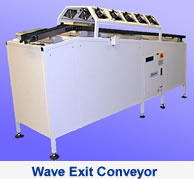
Following the Pick & Place machine an inspection conveyor transfer boards into the soldering machine. When "Surface Mount Technology" (SMT) is involved this would be a reflow oven. In this type of soldering machine the PCBs travel inside the oven, which provides a controlled temperature profile to melt "Reflow" the solder paste soldering on the components.
When using "Through Hole" assembly methods a Wave Solder Machine would be used to solder the components. In this type of machine the PCBs travel over a "Wave" of solder with just the bottom of the board in contact with the molten solder. This solders the component leads sticking through the holes on the board to the circuit wiring, "printed" on the bottom of the board. The boards travel up a slight incline inside most wave-solder machines. In order to return the boards to Line Height a special Wave Exit Conveyor is required. These are custom made to match the specific exit height of the wave-solder machine chosen and have a decline returning the board to the normal line height. Most wave exit conveyors also incorporate cooling fans to reduce board temperature before the downstream operations.
Back to the Top
Accumulation 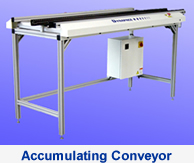
At the exit of the solder machine it is always a good idea to have some type of storage device that will pass product through unless there is a stoppage downstream. Depending on how many boards are going to be in your solder machine (oven) when the line is running you need to have some way to empty the solder machine in the event of a stoppage downstream from the solder machine. If the conveyor inside the solder machine just stopped the boards remaining within the machine would be destroyed by the heat. Depending on the total number of inches of board in the solder machine the solution could be as simple as having an accumulating conveyor at the exit of the oven. If something with more capacity is needed a LIFO (Last in First Out Vertical Buffer Storage unit) would allow you to empty the solder machine into the buffer. Then when the downstream line starts up again the buffer will empty feeding the downstream line. Preference is given to incoming product before the unloading process begins. If the downstream process stops, both of these alternatives will send a signal upstream to the unit feeding the oven telling it to stop sending boards.
Back to the Top
Double Sided Boards 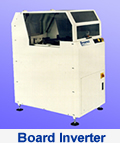
If product design has the board populated on both sides, as many are today, a "Board Inverter" downstream from the storage buffer will be required. This takes the board and simply flips it over, leading for trailing edge, and sends it on to a second screen printer that will apply solder past to side 2 in preparation for component attachment. Next will come a second component placement process with associated feed and exit conveyors, and a second reflow oven. A second buffer storage device would follow.
Back to the Top
Double Sided Alternate Approach
Another approach can be used which eliminates the second screen printer; pick and place machine and reflow oven. This method can be used when there is a mix of one and two-sided product being assembled and the volume of two sided is not high enough to justify a continuous line. In this situation an inverter and a magazine loader would be located at the end of the line storing the boards until they can be re-introduced up stream at a later time to complete the second side of the board. It is also possible to load the magazines manually at the end of the line. As with most decisions regarding assembly line layout it comes down to capital investment in automation verses labor costs. The magazine is then manually moved to a magazine unloader upstream of the bare board loader. The magazine unloader feeds the boards at the beginning of the line upstream of the bare board loader which passing them though to the screen printer for application of solder paste to the second side of the board. The boards then make a second pass through the pick & place machine and reflow oven completing the second side of the board.
Back to the Top
Cleaning & Testing
At this stage the board is fully populated. Depending on product requirements cleaning and testing may be next. If your board has been completely assembled you may choose to incorporate a board cleaner (washer) at this point. PCB cleaners are used to remove residue from the soldering operation. The PCBs would move from the storage device to a board cleaner then on to a test station. There are a variety of PCB testing systems available. Some, such as examination of solder paste application, X-Ray and optical testing for component placement may be done at earlier stages prior to soldering. In some cases the final testing also incorporates programming of chips on the PCB and may include printing barcodes or other information on the board. In almost all cases it is necessary to connect to the PCB in order to apply power and make circuit tests. One popular way of doing this is through the use of a so called "Bed of Nails" in which a bed of spring loaded contacts is pressed against the PCB making contact with specific points on the board allowing the circuit to be activated and programming or tests to be conducted. 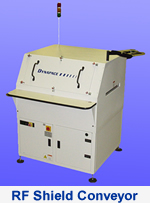 This can be done automatically with a conveyor that incorporates the test station. Dynapace can custom engineer a conveyor suited to your testing needs. On a PCB with a connector it is also possible to automatically plug in to this connector and perform tests.
This can be done automatically with a conveyor that incorporates the test station. Dynapace can custom engineer a conveyor suited to your testing needs. On a PCB with a connector it is also possible to automatically plug in to this connector and perform tests.
In some situations radio frequency (RF) devices need to be tested during the assembly process. This can require special shielding to prevent radio waves from interfering with other nearby equipment. To make this job easer Dynapace has developed an RF shielded enclosure built around a 1-Meter Edge Carry conveyor that allows RF testing within the enclosure. Doors on the entry and exit open and close to admit the board for test, close for testing and open to pass the board to the downstream station.
Back to the Top
Automated In-line Inspection
There are a variety of ways to handle sorting good product from bad following an automated inline inspection process. The choice of system will depend on a number of factors including the volume of product, what type of rework is required and the degree of automation you want to achieve. The following are a few of the basic approaches.
 1. Use a Programmable Automatic Turntable (PATT) or Shuttle transfer table on the output of the test station, which would send good product on to the next operation and divert bad product to a sideline. Re-work can then be completed and the product inserted in the line, for re-inspection, just ahead of the test station by a second turntable. Variations of this approach will depend on the type of rework needed, the next operation (re-flow, final assembly or packaging etc.) and the volume of product. Keep in mind that when there is a re-work station located in a sideline it will need to be staffed in order to avoid backs-ups as the sideline becomes full. Depending on the frequency, kind and time required for rework this could be a very efficient approach.
1. Use a Programmable Automatic Turntable (PATT) or Shuttle transfer table on the output of the test station, which would send good product on to the next operation and divert bad product to a sideline. Re-work can then be completed and the product inserted in the line, for re-inspection, just ahead of the test station by a second turntable. Variations of this approach will depend on the type of rework needed, the next operation (re-flow, final assembly or packaging etc.) and the volume of product. Keep in mind that when there is a re-work station located in a sideline it will need to be staffed in order to avoid backs-ups as the sideline becomes full. Depending on the frequency, kind and time required for rework this could be a very efficient approach.
2. Another approach is to route defective product to a buffer where it can be stored for delivery to the re-work area at a later time. A Magazine Buffer or Vertical Buffer Storage (LIFO) can handle this job. Here there are a number of arrangements but in general these allow good product to pass through to the next operation and the bad product is diverted into the Buffer. The Magazine Buffer offers the advantage of being able to take magazines full of defective product to the re-work station in convenient batches without having to stop the flow of product on the line. With the VBS the operator needs to stop the flow and manually purge the buffer when it is full. In this case the individual defective boards need to be removed from the line by hand and carried to the re-work area.
There are a wide range of layouts possible depending on your product and situation.
Dynapace offers a simple inline LIFO Rejection Buffer Storage with a built in workstation that allows for the storage of defective boards which can be purged one at a time to the workstation for re-work.
Interconnecting Edge Carry Conveyors
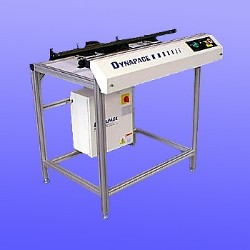 Short interconnecting PCB conveyors will be needed between most machines in the production line. These create one or two board buffers spaced throughout the line to make up for small differences in process times. Also these short interconnect conveyors allow a place to access the line manually should the need arrise. The exact layout will depend on the processes used, the design of the equipment chosen and your floor plan layout. Some of these can also serve as inspection stations.
Short interconnecting PCB conveyors will be needed between most machines in the production line. These create one or two board buffers spaced throughout the line to make up for small differences in process times. Also these short interconnect conveyors allow a place to access the line manually should the need arrise. The exact layout will depend on the processes used, the design of the equipment chosen and your floor plan layout. Some of these can also serve as inspection stations.
Back to the Top
Thru Line Walkways
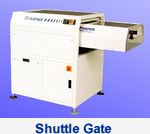 Also it may be desirable to have a walkway through the production line. A Shuttle Gate can provide a normally open or normally closed walkway across the production line. Programed for normally open it closes only when needed to pass a board from one part of the line to the next. Sensors that prevent the shuttle gate from closing when someone is standing in the way protect the workers. Setup for normally closed the gate remains closed until a person steps on a mat signaling the gate to open at the next opprotunity.
Also it may be desirable to have a walkway through the production line. A Shuttle Gate can provide a normally open or normally closed walkway across the production line. Programed for normally open it closes only when needed to pass a board from one part of the line to the next. Sensors that prevent the shuttle gate from closing when someone is standing in the way protect the workers. Setup for normally closed the gate remains closed until a person steps on a mat signaling the gate to open at the next opprotunity.
In situations when less frequent access through the line is required, possibly for maintenance access, Dynapace also offers a Lift gate that is manually raised to allow access.
Back to the Top
Manual Assembly 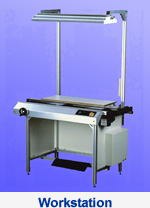
For some applications hand placement of some components, such as battery clips or heat sinks, may be typical. Edge Carry Workstations are design to meet those needs and provide convenient access for your workers to the PCBs traveling along that portion of the line. The Workstation is an Edge Carry Transfer Conveyor with a work surface in front, an overhead light and a place for parts bins. These are normally 2 or 3 zone conveyors, which allow boards to enter the workstation, stop and then be released to the downstream line by the operator after completing their task. Both Edge Carry and Flat Belt workstations are available depending on your requirements.
Slideline & Progressive Assembly 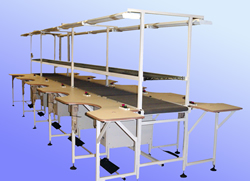
There are still many cases where "Through Hole" technology is used particularly for larger size components. In some cases hand placement of components is the preferred assembly method because of the high capital investment required for automated equipment. This can be best accomplished on a manual slide line along which boards are moved or "slid" along by the operator from one work position to the next where each worker adds components to the board. At the end of the line the PC boards are fed into a wave solder machine. They can be fed continuously or in batches depending largely on the volume of boards being produced and the time between boards.
Dynapace offers a wide range of standard and custom PCB handling equipment that can be configured to optimize product flow on your production line. A Dynapace representative will be happy to evaluate your needs and make recommendations, which will offer you cost effective product transport solutions.
Back to the Top